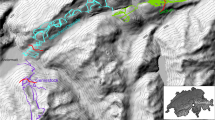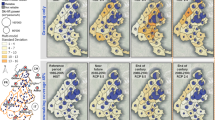Abstract
Inter-annual snow reliability is a key short-term concern for Arizona’s high elevation, low latitude ski resorts. Variability is linked to the El Niño Southern Oscillation (ENSO)–warm phase conditions typically portend a good ski season and vice versa. To operate more consistently in the medium-term Arizona’s two largest ski resorts plan to expand snowmaking. Snowmaking is a water and temperature constrained adaptation. One of the two resorts has overcome its water constraint by contracting with a municipality for treated wastewater. To assess the temperature constraint downscaled global coupled climate model temperature projections were compared to technical thresholds for the manufacture of snow at three time steps. In 2030, a period coincident with the lifetime of the investments, snowmaking will likely remain feasible. However, by 2050, temperatures will likely exceed technical thresholds in the shoulder seasons meaning that in years when natural snowfalls are poor the ski season may be curtailed. By 2080, without snowmaking efficiency improvements, warmer temperatures will make snowmaking increasingly more expensive and resort managers may need to plan for a future where operations and snowmaking are shifted to higher elevation, shaded, more snow reliable runs.
Similar content being viewed by others
References
Adger WN, Agrawala S, Mirza MMQ, Conde C, O’Brien K, Pulhin J, Pulwarty R, Smit B, Takahashi K (2007) Assessment of adaptation practices, options, constraints and capacity. In: Parry ML, Canziani OF, Palutikof JP, van der Linden PJ, Hanson CE (eds) Climate change 2007: impacts, adaptation and vulnerability. Contribution of working group II to the fourth assessment report of the intergovernmental panel on climate change. Cambridge University Press, Cambridge, pp 717–743
Arizona Snowbowl (2007) Resort info—rates. http://www.arizonasnowbowl.com/resort/rates.html. Accessed 7 Feb 2008
Behringer J, Buerki R, Fuhrer J (2000) Participatory integrated assessment of adaptation to climate change in alpine tourism and mountain agriculture. Integrated Assessment 1:331–338
Bloomfield J, Hamburg SP (1997) Seasons of change: global warming and New England’s white mountains. Environmental Defense Fund, New York, 33 pp
Breiling M, Charamza P (1999) The impact of global warming on winter tourism and skiing: a regionalised model for Austrian snow conditions. Regional Environmental Change 1(1):4–14
Breiling M, Charamza P, Skage O (1997) Klimasensibilitat Osterreichischer Bezirke mit besonderer Berucksichtigung des Wintertourismus. Report 97:1. Institute for Landscape Planning, Alnarp
Bürki R, Elsasser H, Abegg B (2003) Climate change—impacts on the tourism industry in mountain areas. In: 1st international conference on climate change and tourism, Djerba, Tunisia, 9–11 April 2003
Cayan DR, Redmond KT, Riddle LG (1999) ENSO and hydrologic extremes in the Western United States. J Clim 12:2881–2893
Christensen N, Lettenmaier DP (2006) A multimodel ensemble approach to assessment of climate change impacts on the hydrology and water resources of the Colorado River basin. Hydrol Earth Syst Sci Discuss 3:3727–3770
Cordell HK, Bergstrom JC, Hartmann LA, English DBK (1990) An analysis of the outdoor recreation and wilderness situation in the United States 1989–2040. A technical document supporting the 1989 RPA assessment. In: The demand for outdoor recreation and wilderness, chapter 11, pp 27–46
Diffenbaugh NS, Pal JS, Trapp RJ, Giorgi F (2005) Fine-scale processes regulate the response of extreme events to global climate change. Proc Natl Acad Sci U S A 102(44):15774–15778
Dominguez F, Cañon J, Valdes J (2009) IPCC-AR4 climate simulations for the Southwestern US: the importance of future ENSO projections. Clim Change (in press)
Echelberger HE, Shafer EL Jr (1970) Snow + X = use of ski slopes. J Mark Res VII(August): 388–392
Elsasser H, Bürki R (2002) Climate change as a threat to tourism in the Alps. Clim Res 20:253–257
Galloway RW (1988) The potential impact of climate changes on Australian ski fields. In: Pearman GI (ed) Greenhouse: planning for climate change. CSIRO, Melbourne, pp 428–437
Giorgi F, Mearns LO (2002) Calculation of average, uncertainty range, and reliability of regional climate changes from AOGCM simulations via the “reliability ensemble averaging” (REA) method. J Clim 15:1141–1158
Goski.com (2007) Mt. Lemmon ski valley reviews. http://www.goski.com/resorts/usazlemmon/resort_welcome.html?cnttry_or_state=state&rorc=arizona&from=state&bc=RIR. Accessed 23 Aug 2007
Hamilton LC, Rohall DE, Brown BC, Hayward GF, Keim BD (2003) Warming winters and New Hampshire’s lost ski areas: an integrated case study. Int J Sociol Soc Policy 23(10):52–73
Hamilton LC, Brown C, Keim BD (2007) Ski areas, weather and climate: time series models for New England case studies. Int J Climatol 27:2113–2124. doi:10.1002/joc.1502
Harris T (2007) How snowmakers work: costs of snow-making. http://science.howstuffworks.com/snow-maker6.htm. Accessed 21 Aug 2007
Harrison SJ, Winterbottom SJ, Sheppard C (1999) The potential effects of climate change on the Scottish tourist industry. Tour Manage 20:203–211
Hudson S (2000) The segmentation of potential tourists: constraint differences between men and women. J Travel Res 38:363–368
IPCC (2007) Climate change 2007: synthesis report, summary for policymakers. IPCC. http://www.ipcc.ch/thenar4_syr_spm.pdf
Joseph R, Nigam S (2006) ENSO evolution and teleconnections in IPCC’s twentieth-century climate simulations: realistic representation? J Clim 19:4360–4377
Kalnay E, Kanamitsu M, Kistler R, Collins W, Devan D, Gandin L, Iredell M, Saha S, White G, Woollen J, Zhu Y, Leetman A, Reynolds B, Chelliah M, Ebisuzaki W, Higgins Janowiak J, Mo KC, Ropelewski C, Wang J, Jenne R, Joseph D (1996) The NCEP/NCAR 40-year reanalysis project. Bull Am Meteorol Soc 77(3):437–471
Knowles N, Dettinger MD, Cayan DR (2006) Trends in snowfall versus rainfall in the western United States. J Clim 19:4545–4559
König U (1998) Tourism in a warmer world: implications of climate change due to enhanced greenhouse effect for the ski industry in the Australian alps. Wirtschaftsgeographie und Raumplanung, vol 28. University of Zurich, Zurich, Switzerland
König U, Abegg B (1997) Impacts of climate change on tourism in the Swiss Alps. J Sustain Tour 5(1):46–58
Lamonthe and Périard Consultants (1998) Implications of climate change for downhill skiing in Quebec. Climate change digest 88-03. Environment Canada, Ottawa
Livezey RE, Timofeyeva MM (2008) The first decade of long-lead U.S. seasonal forecasts insights from a skill analysis. Bull Am Meteorol Soc 89(6):843–854
Marcin TC (1993) Demographic change—implications for forest management. J For 91(11):39–45
Maurer EP (2007) Uncertainty in hydrologic impacts of climate change in the Sierra Nevada, California, under two emissions scenarios. Clim Change 82:309–325
Maurer EP, Wood AW, Adam JC, Lettenmaier DP, Nijssen B (2002) A long-term hydrologically-based data set of land surface fluxes and states for the conterminous United States. J Clim 15:3237–3251
McBoyle GR, Wall G (1992) Great lakes skiing and climate change. In: Gill A, Hartmann R (eds) Mountain resort development. Center for Tourism Policy and Research, Simon Fraser University, Burnaby, pp 77–81
McBoyle B, Mills B, Minogue A (2004) Climate change and the ski industry in North America: a reassessment. In: Matzarakis A, de Freitas CR, Scott D (eds) 2004: advances in tourism climatology. Ber Meteor Inst Univ Freiburg Nr 12
Morey ER (1984) The choice of ski areas: estimation of a generalized CES preference ordering with characteristics. Rev Econ Stat 66(4):584–590
Mote PW, Hamlet AF, Clark MP, Lettenmaier DP (2005) Declining mountain snowpack in western North America. Bull Am Meteorol Soc 86 (1):39–49
Murray JR (2006) Snowbowl to open Dec. 8 if we had snowmaking. http://www.arizonasnowbowl.com/news/snowmaking.html. Accessed 21 August 2007
Musselman KN, Molotch NP, Brooks PD (2008) Effects of vegetation on snow accumulation and ablation in a mid-latitude sub-alpine forest. Hydrol Process. doi:10.1002/hyp.7050
Navajo Nation vs. USFS (2007) United States court of appeals for the ninth circuit. no. 06-15371, filed 12 March 2007
Northern Watertek (2007) Newsletter SkiFax #1. http://www.watertek.org/SkiFax1.htm. Accessed 25 Oct 2007
OECD (2006) Climate change in the European alps: adapting winter tourism and natural hazards management. http://www.oecd.org/document/45/0,2340,en_2649_34361_37819437_1_1_1_1,00.html#Summaries. Accessed 4 Oct 2007
Philip SY, van Oldenborgh GJ (2006) Shifts in ENSO coupling processes under global warming. Geophys Res Lett 33. doi:10.1029/2006GL026196
Ratnik Industries (2007) Snowmaking 101. http://www.ratnik.com/snowmaking.html. Accessed 25 Oct 2007
Scott D, McBoyle G, Mills B (2003) Climate change and the skiing industry in southern Ontario (Canada): exploring the importance of snowmaking as a technical adaptation. Clim Res 23:171–181
Scott D, McBoyle G, Mills B, Minogue A (2006) Climate change and the sustainability of ski-based tourism in eastern North America: a reassessment. J Sustain Tour 14(4):376–398
Scott D, McBoyle G, Minogue A (2007) The implications of climate change for the Québec ski industry. Global Environ Change 17:181–190
Ski Resorts Guide (2007) Arizona Snowbowl http://www.skiresortguide.com/stats.cfm/az04.htm and Sunrise Park Resort http://www.skiresortguide.com/stats.cfm/az03.htm. Accessed 21 Oct 2007
Slough A (2006) Arizona’s native deep. http://www.skimag.com/skimag/features/article/0,12795,325810,00.html
Snocountry Mountain Reports (2007) http://www.snocountry.com/snowclient/displayinfox.php?action=blurb&from=profile&permcode=602003. Accessed 6 Feb 2008
Snowmass Village Sun (2007) The art of making snow. http://www.snowmassvillagesun.com/home.php?content=article&article=1453. Accessed 23 Aug 2007
Sunrise Park Resort (2007) Lift tickets. http://www.sunriseskipark.com/lifttickets.shtml. Accessed 21 Oct 2007
Trenberth KE (1997) The definition of El Niño. Bull Am Meteorol Soc 78:2771–2777
USDA (2005) Final environmental impact statement for Arizona snowbowl facilities improvements, vol 1. Coconino National Forest, Coconino County, Arizona
US NAT (National Assessment Team) (2000) Climate change impacts on the United States: the potential consequences of climate change variability and change. US Global Change Research Program. Cambridge University Press, New York
van Oldenborgh GJ, Philip SY, Collins M (2005) El Niño in a changing climate: a multimodel study. Ocean Sci 1:81–95
Wood AW, Maurer E, Kumar A, Lettenmaier D (2002) Long range experimental hydrologic forecasting for the eastern U.S. J Geophys Res 107(D20):4429
Wood AW, Maurer E, Kumar A, Lettenmaier D (2007) Uncertainty in hydrologic impacts of climate change in the Sierra Nevada, California, under two emissions scenarios. Clim Change 82:309–325
Author information
Authors and Affiliations
Corresponding author
Rights and permissions
About this article
Cite this article
Bark, R.H., Colby, B.G. & Dominguez, F. Snow days? Snowmaking adaptation and the future of low latitude, high elevation skiing in Arizona, USA. Climatic Change 102, 467–491 (2010). https://doi.org/10.1007/s10584-009-9708-x
Received:
Accepted:
Published:
Issue Date:
DOI: https://doi.org/10.1007/s10584-009-9708-x




